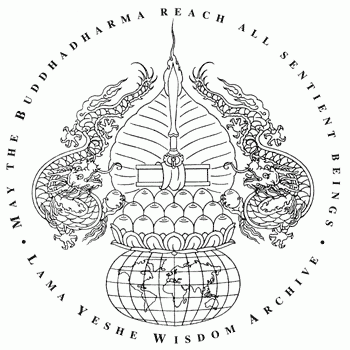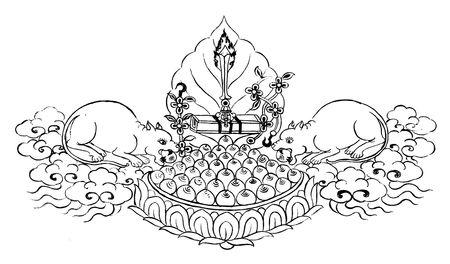Logos for Centers and Projects

Logos for centers, projects and services
Advice from Lama Zopa Rinpoche to all FPMT centers, projects and services
The logo is not just a design of your company, or something to identify with—thinking in this way has no meaning, and it is very uninteresting, boring.
The Tibetan government and lamas understand that the logo has great meaning and significance. In Tibet many lamas used the eight auspicious signs in their logos and Kyabje Trijang Rinpoche had a wish-fulfilling vase (the significance of the wish-fulfilling vase is that you become wish-fulfilling to all sentient beings.)
I would like to advise all FPMT centers, projects and services that the main implement in the logo can be one of the eight auspicious signs. This is because each of the eight auspicious signs have great meaning, so any of them can be used as the main implement in the logo.
Then apart from the main implement, all logos should have:
A pile of jewels
This has two meanings: one is to have wealth—not only external wealth, but inner wealth: the wealth of Dharma understanding and realizations. Also for all the Sangha to be able to fulfill the wishes of all sentient beings. Then the second meaning is to become wish-fulfilling for all sentient beings. This creates the cause to have success and to have all the realizations from guru devotion up to enlightenment and to be able to fulfill the wishes of all sentient beings.
If the main implement is of wealth, the logo must include some drawing symbolizing Dharma (ie, a text).
The world
This signifies the place and sentient beings in this world and in other worlds. The implement being on the world signifies that the center, service and project exists to benefit all sentient beings, the whole world, and that the whole world is supporting the center, service and project.
A lotus
Signifies coming out of the mud, and that sentient beings' minds are in nature pure, unstained by true existence, like the lotus born from mud but unstained. The lotus also signifies the Sangha—the pure monks and nuns—being wish-fulfilling for all beings and bringing all sentient beings to achieve the whole path to enlightenment.
A bodhi leaf
This signifies that bodhicitta is your heart practice; your aim is to benefit sentient beings, to develop your center, service and project to cause all sentient beings to have bodhicitta. Also that bodhicitta is the main aim of your center, service and project. It also signifies that all practices on the path to enlightenment, from guru devotion up to enlightenment, must come from the good heart—bodhicitta—the thought of benefiting others. The bodhi leaf also signifies that the way you guide numberless sentient beings is with bodhicitta, the good heart: that the main goal (of your center, service, project, monastery, nunnery and even country) is to benefit sentient beings and therefore everything you do in your life is with bodhicitta, whether you are teaching, listening, reflecting, from beginning to end, it is done with bodhicitta, including eating, sleeping, walking, sitting, everything is harmonized with bodhicitta, the wish to achieve enlightenment to liberate numberless sentient beings from the lower realms and to bring them to full enlightenment.
You can either have one bodhi leaf behind, or many smaller bodhi leaves—you can see a few examples in logos that I have already designed.
Beams emitting from the bodhi leaf
Signify spreading the light of Dharma in the ten directions to all sentient beings and dispelling the darkness of all sentient beings.
Sometimes the main implement of the logo is a text, sword, or bell and vajra (sometimes together and sometimes separately). These implements are very auspicious and each has special significance.
A sword signifies in particular Lama Tsongkhapa’s unmistaken right view, understanding the middle way, also cutting the root of samsara and revealing the truth to others. The sword of wisdom realizing emptiness cuts the root of samsara for oneself and for all sentient beings. This is the same significance of the sword that Lama Tsongkhapa and Manjrushri are holding.
A text signifies the text which reveals the whole path to enlightenment via listening, reflecting and meditating on it. Also understanding the teachings and being able to achieve the whole path. It also signifies what is explained by Buddha in the text.
A bell and vajra signify method and wisdom—the same as is explained in sadhanas.
Beams radiating out from an implement signify that the center, service and project are continually benefiting sentient beings. The beams signify that everyone who comes there receives all realizations, and that the center, service and project will continually benefit sentient beings up to enlightenment, liberate all sentient beings without effort, spontaneously, from all the sufferings by eliminating the darkness of ignorance on the mental continuum, by the light of Dharma. This is the same as in a sadhana when Buddha sends beams of light out, eliminating all the defilements etc.
Dragons
Signify strength—to be very strong in one’s heart and mind, strong in Dharma practice, strong in higher training—morality, the vows, higher concentration, wisdom, also to overcome all the obstacles—the inner obstacles, delusions and the outer obstacles, such as financial needs.
Dragons are very, very important in logos and you need to have a dragon on each side. It is very important for the logos to have dragons, this makes the center, service and project very stable and strong and this benefits the whole organization, it makes the organization become strong. This is similar to advice that I have given in the past on the reason why centers, projects and services should have dragons outside on the front door. It makes the center, service and project very strong.
For example, Bhutan has a dragon on its money, and even though it is a very tiny country, it has always stayed strong, it has not been taken over by India or China and also the Dharma has stayed very strong in Bhutan. Singapore also has dragons on its money.
The dragons must hold a jewel in each hand, it is very important they are not empty handed. The dragons need to be very clear, vivid and not messy. It is best if the dragons are embossed.
Then you can have a banner below the logo with the name of the center, service and project or you can have Dharma words or a quote in the banner.
All the logos that I have designed for centers have these similar things—except my own logo and the logo of Kopan—these two logos have a garuda and in its heart is a vajra radiating light. Later I added dragons around my logo. My own logo has one line from Arya-mañjushri-nama-samgiti, it says: The doer who is doing works for sentient beings.
So this is just a general idea for all logos. When a center, service or project asks someone to create a logo, it is important that it is a good artist, Tibetan or Western. They can use the above as a basis, and in addition they can beautify the logo overall with flowers, birds, the eight auspicious signs below the banner, or a quote/Dharma words below the banner.
It would be best if the logo was embossed, and definitely not light or fading in color. If the logo is embossed this helps for the center to become strong.
If the center, service or project is going to create a logo, it is important to first check if the same logo has been created already, so as not to have duplicate logos.
I want everyone to understand the meaning and significance of logos, because I am now seeing some centers, services and projects are creating funny logos. It seems they have no real idea of the meaning and significance of the logos.
Colophon: Scribe Holly Ansett, Buddha Amitabha Pure Land, WA, USA 19 Nov 2010; lightly edited by Claire Isitt, 28 Jan 2011.
In brief, Rinpoche’s advice is for FPMT logos ideally to include these elements:
- A main implement, which can be one of the eight auspicious symbols or a text, sword, vajra and bell, or other appropriate symbol
- A pile of jewels
- The world
- A lotus
- A bodhi leaf/leaves emitting beams
- A dragon on each side holding a jewel in each hand
Examples:


Center Logo
Rinpoche described the following for the logo for a Dharma center.
The logo should have a lotus with many petals, like the type a Buddha statue sits on. There should be big piles of jewels. On top of that is a sutra text. There is sunlight all around.
The explanation is that the lotus is the heart. Through the Buddha’s teachings, delusion is eliminated. The sun signifies eliminating the darkness of delusions, of wrong concepts, karma, true sufferings and resultant sufferings, even subtle defilements, by revealing the complete Mahayana path of sutra and tantra, causing liberation and enlightenment. The piles of jewels signify fulfilling all sentient beings’ wishes for happiness. The whole meaning of the logo is the function of the center. The center is fulfilling the wishes of sentient beings through the Golden Light Sutra and teachings of the Buddha, the Lesser Vehicle, Mahayana Paramitayana teachings, and Mahayana tantra teachings.
The words can be underneath in the form of a banner. It would be good if they could be embossed. You could have yellow paper with red embossed words. If the paper is white, the words can still be embossed in red.
Monastery Logo
Rinpoche offered some money on Buddha Day (Lha bab duchen) towards building the new Nalanda Monastery in France. They sent back a thank-you letter. When Rinpoche read it he made these comments about the monastery’s logo.
The logo needs to be more integrated. These are my suggestions:
The two hands should hold one lotus that blossoms in the middle, then above the two hands, on that lotus, there should be the text, and above that the sword, so, that means, one above each other.
There should be a bodhi leaf behind (see my drawing of a bodhi leaf attached) and also beams coming from the bodhi leaf. The logo really needs the bodhi leaf behind to make it more integrated.
The two hands signify guiding sentient beings, revealing the path: method and wisdom, first actualizing it within yourself and then guiding sentient beings by showing the two paths.
The three fingers standing up signify revealing the gradual path of the lower capable being, the gradual path of the middle capable being, and the gradual path of the higher capable being.
The finger and thumb touching signifies bringing all sentient beings to enlightenment by the unified state of Vajradhara, the unified holy body and mind.
The lotus, text, and sword signify in particular Lama Tsongkhapa’s unmistaken right view, understanding the middle way, also cutting the root of samsara and revealing the truth to others. The sword of wisdom realizing emptiness cuts the root of samsara for oneself and for all sentient beings.
The text reveals the whole path to enlightenment, through listening, reflecting, and meditating—understanding the teachings and able to achieve the path.
The bodhi leaf signifies that all practices on the path to enlightenment, from guru devotion up to enlightenment, must come from the good heart, bodhicitta, the thought of benefiting others. From the very beginning, all the stages of the path must come from bodhicitta.
The bodhi leaf also signifies the way you guide numberless sentient beings with bodhicitta, the good heart. Bodhicitta is the heart practice, we bring that to everyone. This is what makes it possible to achieve enlightenment.
The beams emitting from the bodhi leaf signify spreading the light of Dharma to all sentient beings and dispelling the darkness of all sentient beings. It signifies bringing the light of Dharma in the ten directions.
The piles of jewels signify receiving all needs and the necessary conditions to complete the path, especially for all the Sangha to be able to fulfill the wishes of all sentient beings.
The lotus signifies the Sangha, the pure monks and nuns, being wish-fullfilling for all beings, enabling all sentient beings to achieve the whole path to enlightenment.
Being on the world means Nalanda Monastery exists to benefit all sentient beings, the whole world, and the whole world is supporting Nalanda.
The dragons are for strength, to be very strong in one’s heart and mind, strong in Dharma practice, strong in higher training—morality, the vows, higher concentration, wisdom—also to overcome all obstacles, the inner obstacles—delusions—and the outer obstacles, such as economic needs.
It is best if the logo can be embossed, if not the whole logo, then at least the dragons.
So, this is my advice regarding the logo.
Universal Education Logo
Rinpoche sent the following advice on how to design a logo for the FPMT project in schools: Universal Education (UE).
My dear George, who is enriched with wisdom and devotion to Buddha, Dharma, and Sangha, and compassion to others, fully dedicated, as well as the other staff. All of you have these most important qualities, with which to enlighten sentient beings.
Usually, when I make letterheads for centers, monasteries, and so forth, it all has great significance—based on the two truths, wisdom and method, rupakaya and dharmakaya.
Here is the Universal Education logo for the letterhead (attached). The world signifies the place and sentient beings in this world and in other worlds. The lotus signifies the mind of sentient beings, which has potential Buddha nature. The pata (endless knot) signifies great compassion encompassing all sentient beings (so no one is left out), especially the attitude of total responsibility to free sentient beings from suffering and to cause them happiness, particularly ultimate happiness—enlightenment. So, this is the motivation for UE.
The sun signifies all wisdom—Dharma wisdom, the five wisdoms, and ultimate wisdom. This can signify eliminating the darkness of ignorance of sentient beings and thus fully enlightening them. Then, it is also Dharma wisdom—knowing what is right, what benefits oneself and others, and knowing what is wrong, what harms oneself and others. Then, there is ultimate wisdom, the wisdom realizing emptiness. There are also the five wisdoms.
The wish-granting jewel signifies that all sentient beings’ wishes for happiness can be fulfilled. By educating with UE, we generate compassion and wisdom, which is the whole path. Through this, all beings’ wishes for temporary happiness for this life and all their future lives, and ultimate happiness, full enlightenment, can be actualized.
This signifies that each of the students attending Universal Education will cause that (wish for happiness) for all sentient beings by developing compassion and wisdom in their hearts. First, the pata and sun, show that the FPMT organization fulfills the wishes of all sentient beings. Second, it is the students who fulfill the wishes of all sentient beings.
The banner (which says Universal Education) can have some Dharma words on it (like the Kopan logo). We can move "Universal Education" below the banner. The reason why I put jewels in the logos is for wealth and prosperity for the centers. Without money, one cannot do anything. Money, along with compassion and wisdom, can benefit sentient beings. You can look at the Maitreya logo—it is a good logo.
Thank you very much. Enjoy enlightening sentient beings. Ha ha, hee hee, hoo hoo, yam yam, with bodhicitta.
With much love and prayers...

